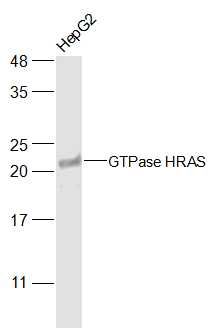产品货号 : mlR6165
英文名称 : GTPase HRAS
中文名称 : 转化蛋白p21抗体(原癌基因H-ras抗体)
别 名 : p21ras; Transforming protein p21; GTPase HRas; GTPase KRas; HRas; HRAS1; KRas; KRAS2; RASH; RASK; RASH_HUMAN; RASK_HUMAN.
研究领域 : 肿瘤 细胞生物 信号转导 转录调节因子 G蛋白偶联受体
抗体来源 : Rabbit
克隆类型 : Polyclonal
交叉反应 : Human, Mouse, Rat, Chicken, Cow, Horse,
产品应用 : WB=1:500-2000 ELISA=1:500-1000 IHC-F=1:400-800 IF=1:100-500 (石蜡切片需做抗原修复)
not yet tested in other applications.
optimal dilutions/concentrations should be determined by the end user.
分 子 量 : 21kDa
细胞定位 : 细胞核 细胞浆
性 状 : Lyophilized or Liquid
浓 度 : 1mg/ml
免 疫 原 : KLH conjugated synthetic peptide derived from human HRAS+KRAS:51-150/189
亚 型 : IgG
纯化方法 : affinity purified by Protein A
储 存 液 : 0.01M TBS(pH7.4) with 1% BSA, 0.03% Proclin300 and 50% Glycerol.
保存条件 : Store at -20 °C for one year. Avoid repeated freeze/thaw cycles. The lyophilized antibody is stable at room temperature for at least one month and for greater than a year when kept at -20°C. When reconstituted in sterile pH 7.4 0.01M PBS or diluent of antibody the antibody is stable for at least two weeks at 2-4 °C.
PubMed : PubMed
产品介绍background:
The KRAS gene encodes the human cellular homolog of a transforming gene isolated from the Kirsten rat sarcoma virus. The RAS proteins are GDP/GTP-binding proteins that act as intracellular signal transducers. The most well-studied members of the RAS (derived from 'RAt Sarcoma' virus) gene family include KRAS, HRAS, and NRAS. These genes encode immunologically related proteins with a molecular mass of 21 kD and are homologs of rodent sarcoma virus genes that have transforming abilities. While these wildtype cellular proteins in humans play a vital role in normal tissue signaling, including proliferation, differentiation, and senescence, mutated genes are potent oncogenes that play a role in many human cancers.
Function:
Ras proteins bind GDP/GTP and possess intrinsic GTPase activity.
Subunit:
In its GTP-bound form interacts with PLCE1. Interacts with TBC1D10C. Interacts with RGL3. Interacts with HSPD1. Found in a complex with at least BRAF, HRAS1, MAP2K1, MAPK3 and RGS14. Interacts (active GTP-bound form) with RGS14 (via RBD 1 domain) (By similarity). Forms a signaling complex with RASGRP1 and DGKZ. Interacts with RASSF5. Interacts with PDE6D. Interacts with IKZF3. Interacts with GNB2L1. Interacts with PIK3CG; the interaction is required for membrane recruitment and beta-gamma G protein dimer-dependent activation of the PI3K gamma complex PIK3CG:PIK3R6 (By similarity).
Subcellular Location:
Isoform 2: Nucleus. Cytoplasm. Cytoplasm, perinuclear region. Note=Colocalizes with GNB2L1 to the perinuclear region.
Tissue Specificity:
Widely expressed.
Post-translational modifications:
Palmitoylated by the ZDHHC9-GOLGA7 complex. A continuous cycle of de- and re-palmitoylation regulates rapid exchange between plasma membrane and Golgi.
S-nitrosylated; critical for redox regulation. Important for stimulating guanine nucleotide exchange. No structural perturbation on nitrosylation.
The covalent modification of cysteine by 15-deoxy-Delta12,14-prostaglandin-J2 is autocatalytic and reversible. It may occur as an alternative to other cysteine modifications, such as S-nitrosylation and S-palmitoylation.
Acetylation at Lys-104 prevents interaction with guanine nucleotide exchange factors (GEFs) (By similarity).
DISEASE:
Defects in HRAS are the cause of faciocutaneoskeletal syndrome (FCSS) [MIM:218040]. A rare condition characterized by prenatally increased growth, postnatal growth deficiency, mental retardation, distinctive facial appearance, cardiovascular abnormalities (typically pulmonic stenosis, hypertrophic cardiomyopathy and/or atrial tachycardia), tumor predisposition, skin and musculoskeletal abnormalities.
Defects in HRAS are the cause of congenital myopathy with excess of muscle spindles (CMEMS) [MIM:218040]. CMEMS is a variant of Costello syndrome.
Defects in HRAS may be a cause of susceptibility to Hurthle cell thyroid carcinoma (HCTC) [MIM:607464]. Hurthle cell thyroid carcinoma accounts for approximately 3% of all thyroid cancers. Although they are classified as variants of follicular neoplasms, they are more often multifocal and somewhat more aggressive and are less likely to take up iodine than are other follicular neoplasms.
Note=Mutations which change positions 12, 13 or 61 activate the potential of HRAS to transform cultured cells and are implicated in a variety of human tumors.
Defects in HRAS are a cause of susceptibility to bladder cancer (BLC) [MIM:109800]. A malignancy originating in tissues of the urinary bladder. It often presents with multiple tumors appearing at different times and at different sites in the bladder. Most bladder cancers are transitional cell carcinomas. They begin in cells that normally make up the inner lining of the bladder. Other types of bladder cancer include squamous cell carcinoma (cancer that begins in thin, flat cells) and adenocarcinoma (cancer that begins in cells that make and release mucus and other fluids). Bladder cancer is a complex disorder with both genetic and environmental influences.
Note=Defects in HRAS are the cause of oral squamous cell carcinoma (OSCC).
Defects in HRAS are the cause of Schimmelpenning-Feuerstein-Mims syndrome (SFM) [MIM:163200]. A disease characterized by sebaceous nevi, often on the face, associated with variable ipsilateral abnormalities of the central nervous system, ocular anomalies, and skeletal defects. Many oral manifestations have been reported, not only including hypoplastic and malformed teeth, and mucosal papillomatosis, but also ankyloglossia, hemihyperplastic tongue, intraoral nevus, giant cell granuloma, ameloblastoma, bone cysts, follicular cysts, oligodontia, and odontodysplasia. Sebaceous nevi follow the lines of Blaschko and these can continue as linear intraoral lesions, as in mucosal papillomatosis.
Similarity:
Belongs to the small GTPase superfamily. Ras family.
SWISS:
P01112
Gene ID:
3265
Important Note:
This product as supplied is intended for research use only, not for use in human, therapeutic or diagnostic applications.
产品图片 :












